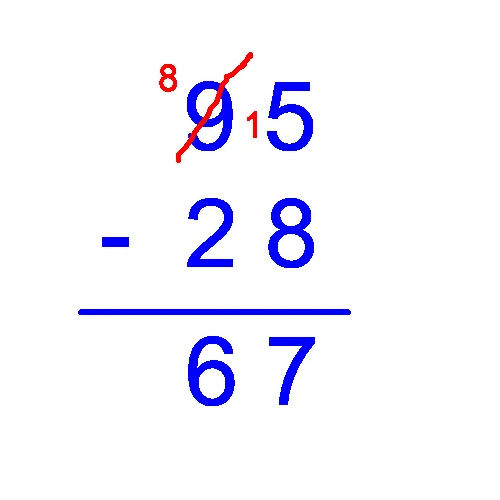Subtraction is one of the four basic operations of arithmetic along with addition, multiplication, and division. Subtracting consists of removing an amount from an initial number, the result that it gives us will be the consequence of a subtraction.

The subtraction process is quite simple, in the same way as the addition, the four operations are the easiest. To subtract, we must eliminate, that is, if they give us a number and tell us that we must remove another, we are eliminating the first one by a second, and the rest will be the result of the subtraction.
In the same way as the addition, it is possible to know when we have done a subtraction, if the result is correct or not. We would simply have to, to the result that it has given us, add the second quantity, that is, the one that we have subtracted from, and if the result of this addition coincides with the first number, that is, from which we have subtracted, it is that our subtraction is well done.
In subtraction, each number, the one above and the one below, receive a name, in the same way as the result. The number placed on the back, or from which it is necessary to subtract, is called the minuendo (because it is the one that you are going to subtract from); the bottom one is called the subtrahend, because it is the amount that you are subtracting from the first one; and the result of subtracting the minuend minus the subtrahend, gives as a result the difference. So from now on minuend (top)-subtrahend (bottom) = difference (result).
You always start to subtract from the right side, because if the unit above exceeds the number 9, we will have to take one. This means that that one will have to be added to the next number on the left.
To divide both small and large numbers, it is best to put one number below the other. If we want to subtract 1234 from 1500, what we have to do is put the largest number on top, although it does not always have to be the largest, since the result can be a negative number, that is, less than 0. We put the number from which something must be subtracted at the top, and below it the number that must be subtracted. We have to match the units with the units, the tens with the tens… for this, the best thing to do is, if the number exceeds a thousand, put the separation points and thus it will be much easier to place it.
In the example above we would have to do 1,500-1,234, the easiest way is to put the second figure below the first and do the following:
- How much is left for 4 to reach 10 (0), we do the result and see that it is 6.
- How much does 3 have left to reach 10 (0), we calculate the result and see that it is 7, but we must bear in mind that we take 1 with us because the number above is greater than 9. So the result is 6.
- How much does 2 have left to reach 5? We do the result and we see that it is 3, but we must take into account that we take 1 again, because the number above exceeds 9 again, that is, it has two digits, and in this case we must always take 1. So the result is 2.
- We see that there is no difference between 0 and 0, so the result is 0.
- We add what he has given us and we see that the result of subtracting 1,500-1,234 is equal to 266.
The easiest way to subtract is to think: how many numbers do I have left to reach the goal? The target would be the minuend. For example, if we have 10-8 we will have to think about how many numbers I have to have to get from 8 (subtrahend) to 10 (minuend). We will have the number 9 and the number 10, therefore the difference is 2.
There are two types of subtraction, those that you don’t take with you and those that you take with you. The ones that you take with you are the ones that we have already explained that I have to remember that I take one with me to add it later to the number on the right. And the ones you don’t take with you are the simplest.
An example to better understand subtraction without taking it would be to subtract the number 3 from 5. The result would be 2, because to get to 5 from 3 we have the number 5 and the number 5, therefore 2. To find out if It is carrying or not is very simple, and it is that the minuend has to be less than the subtrahend. For example, if we have to subtract 28 from 45, since we have to do it number by number, we will have to know how many numbers I need from 8 to get to 5, but in this case 5 is less than 8, then do I have to subtract backwards? No. In this case in which the minuend is less than the subtrahend, it means that it has passed ten. So from 8 we would have to get to 15. How many numbers go from 8 to 15, we have 9, 10, 11, 12, 13, 14 and 15, so there are 7. Now we have to take one when we pass the number 10.
To check, manually, if the subtraction we have done is correct, we have to take two other numbers. Using 45-18 as an example, which has given 17 as a difference, what we have to do is: to 17, which is the difference, add the smallest number of the other two, that is, the subtrahend. 17+18 and it would have to give us the minuend, which is 45. In case the result is not this, it means that we have done something wrong, we would have to delete the result and start the operation again.
Subtraction Tips
- Always check the subtractions you do, you may have done it very quickly and it may not always give you the same result. Especially if you’re learning to subtract, it’s a good idea to do each count twice.
- Place the amounts one below the other. This is much easier than doing it horizontally, because in this second way it is easier to make mistakes.
- Always remember if you take a number, because then you will have to take it into account for the next number on the left.
- Put the points, that is, if the figure exceeds one thousand, put a point to know the numbers it has, in the same way that if it is a decimal and has a comma (,), do not forget to put it because in addition to not the you put the difference will be wrong, so it is easier to place figures one below the other.
- Think. Before starting the subtraction and especially if you find it in a mathematical problem, think about which of the quantities you are given you have to subtract the other, otherwise the difference will go wrong and it is possible that it will even give you a negative number.
